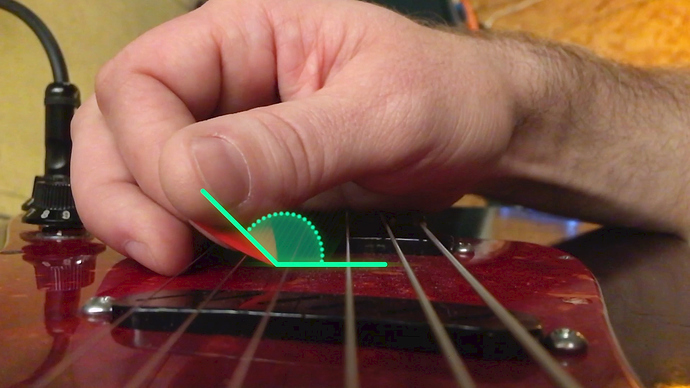I had some ideas here I was going to try to write a new topic but this is just as good probably better. Dwps or forward pick slanting was almost impossible for me , especially on my nylon string elec/acoustic. The problem was I believe as you say, “how can you flatten your hand out enough to actually bury the pick into the string”.
The pick was constantly trying to change the angle back to backward(uwps) pick slanting. I call it forward and backward for the position of the index finger and thumb. In forward slanting picking the index knuckle is rotated toward the middle finger knuckle(you can do it on your knee in the ideal) and the thumb is almost smooth(no bumb). After awhile the index finger can be rotated and held with tension underneath the middle finger without a pick in your hand. Backward pickslanting means your index rotates towards your thumb( a bump is very evident in the thumb knuckle).
Even so this still doesn’t solve the problem doing it on a guitar string with all the tension involved as well as the topography of the strings, bridge and body.
This is what I did to get it going(after not to long perhaps even hours), the motion will be really easy, but I will explain what the problem actually is after I give the solution.
In the G&R video from '87 live from the Roxy the first number is fast and furious and watching Duff Mckegan play confirmed after the fact what I did in fact did do. He wears his bass way way down below his waist(this is a strictly pick side thing so fretting is not important at this point), so that his arm is straight or almost straight with neck close to his shoulder. This will not work sitting down and without a good long strap. This way the issue with flattening your hand is essentially eliminated. Pick a good clip say between 100 bpm and 110 or faster if you like(some music for inspiration), and try that for a while using your whole arm for the motion at first. It worked in one day for me on the lowest string. The next day it was pretty much done on all the strings with the highest string being the hardest and this is why.
The pushing of the string away from center(forward) automatically(without a concerted effort), moves the hand into backward pick slanting(the index knuckle rotating towards the thumb and thumb rotates away thus creating the need for the so called “thumb bump” (seen in the Vinnie Moore CTC video on the soft drink lick), to keep the pick at the correct angle( tip pointing towards the bridge), otherwise the pick could slip out very easily, but in this position if you rotate the index and thumb toward the middle finger you have forward pick slanting.
The reason why it is much easier to do this standing up with your full arm and the instrument way way down is because the motion can be repeated almost perfectly every time and so momentum can build up and you can “learn” it where it counts.
The reason it is so hard to do this sitting down or with the instrument higher up on the body is because the pick wants turn towards the bridge so the hand can avoid the impact of the pick hitting the string. Naturally there are all kinds of solutions to this(keeping the pick point angled towards the bottom string side of the neck), put the middle finger over the index to hold the pick from leaving the angle, putting the middle finger behind the index touching the thumb but not a real two finger grip, the two finger grip(made famous by any number of players), three fingers(any kind of combination of placement), the second finger grip which is perfect for forward pick slanting(EVH), putting any combination of the three last fingers up against the palm(anything to maintain that forward slant while picking in and out repeatedly), and finally the the thumb index grip with the rest of the fingers free floating(the hardest btw).
The flow of the movement must be really secure, otherwise you will miss the string and loose the fluidity. The important point is to make sure that the motion is pushing towards the neck on the in/downstroke and the upstroke takes care of itself, because the tendency is for the body to resist this motion in favor of backslanting/uwps which is why I think essentially uwps is a fudge. I tried but the calluses that had to develop on the underside of the thumb take way to long and the feeling of dwps once you get it is just feels way better(once you are secure the wrist takes over and your off- it’ a great way to palm mute). When one does picking in the air it seems so easy but this type of forward slanting picking motion in and out requires having to work(at first) hard to avoid the strings desire to resist the pressure against it, this where momentum helps tremendously don’t try it too slowly or you won’t create the situation in which the actually issues apply- it is a kind of weight training movement. I really like this way of picking and want to make it my goto in most situations, I’m sure you will get it.
Btw the so called “escape” on the upstroke is so minuscule at fast speed that one has to be really careful about touting it’s effectiveness for string switching, there are definitely caveats.
If this is of any use ask questions.



